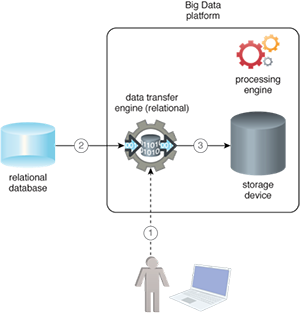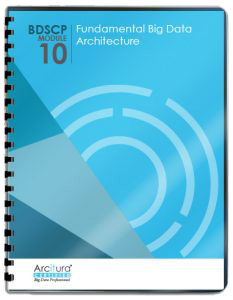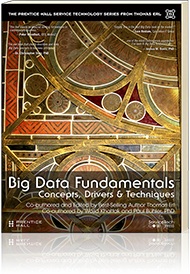Big Data Patterns, Mechanisms > Data Source Patterns > Relational Source
Relational Source (Buhler, Erl, Khattak)
How can large amounts of data be imported into a Big Data platform from a relational database?

Problem
Solution
Application
Mechanisms
A relational data transfer engine component is introduced within the Big Data platform. This component internally uses different drivers and connectors for connecting to different relational databases. The user specifies the connection string and the table from which data needs importing or an SQL query for customizing the data import. In some cases, to accelerate the import of very large amounts of relational data, the relational data transfer engine may internally make use of a processing engine that parallelizes the import process by executing multiple SQL commands in parallel. Based on the availability of suitable connectors, this pattern can also be applied to extract data from data warehouses.
The application of this pattern may be impeded if a database-specific connector is not available. However, a generic connector can normally be used in such circumstances albeit providing suboptimal data transfer speeds.

A capability is added to the Big Data platform that enables it to make a direct connection to the relational database via some user interface. The user interface is used to make a connection to the relational database and specify which data needs importing. Apart from providing a single and a uniform interface for connecting with multiple databases, the application of this pattern further saves time by not having to move between two systems.
- User configures the relational data transfer engine to extract the required data.
- The relational data transfer engine mechanism automatically extracts the required data from the relational database.
- The relational data transfer engine then automatically inserts the data into the storage device without requiring any human intervention.
This pattern is covered in BDSCP Module 10: Fundamental Big Data Architecture.
For more information regarding the Big Data Science Certified Professional (BDSCP) curriculum,
visit www.arcitura.com/bdscp.
The official textbook for the BDSCP curriculum is:
Big Data Fundamentals: Concepts, Drivers & Techniques
by Paul Buhler, PhD, Thomas Erl, Wajid Khattak
(ISBN: 9780134291079, Paperback, 218 pages)
Please note that this textbook covers fundamental topics only and does not cover design patterns.
For more information about this book, visit www.arcitura.com/books.

